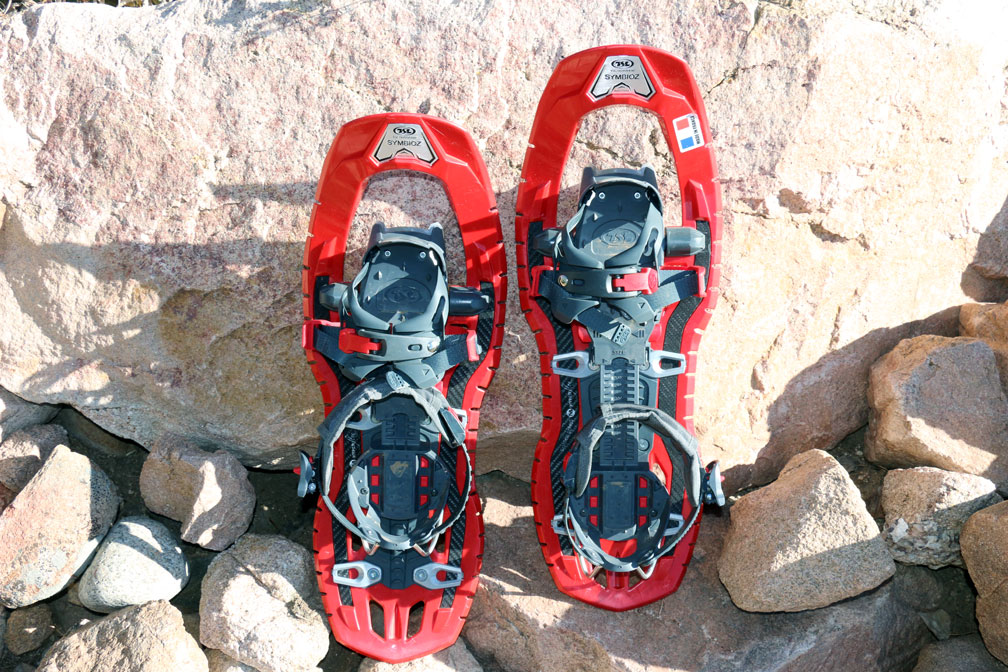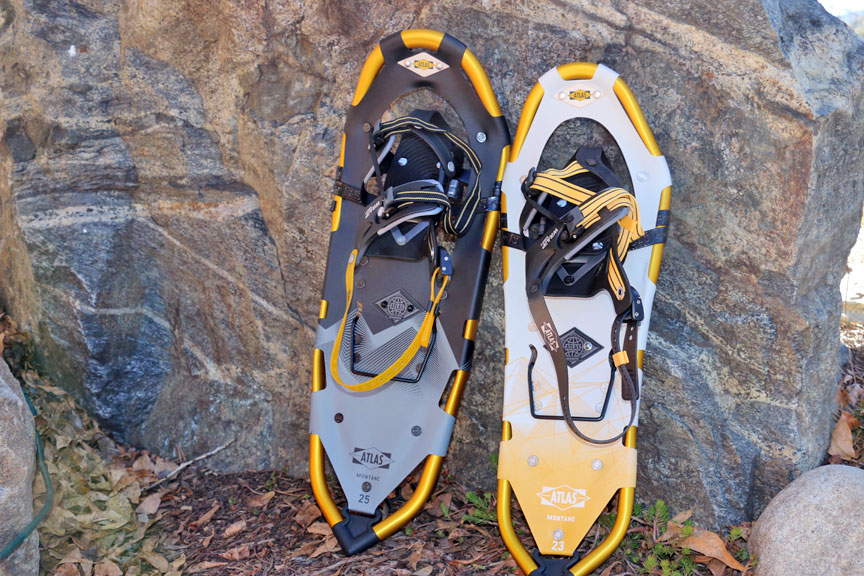|
Story, photos, and video by Murray Selleck, HIKE ROCKY Equipment Specialist. Please note: these reviews are not solicited, and we received no financial compensation for these reviews. Snowshoeing is a wonderful winter extension of your love for hiking in the summer. All your favorite summer trails in Rocky Mountain National Park become easily accessible winter trails with a pair of snowshoes. Snowshoeing offers a completely different yet intimate wintery mountain experience. The soothing yet smothering quiet of a snow-filled forest when you compare it to the noise of our frenzy paced towns and cities is comforting. Watch out when the wind releases snow-loaded pine branches of their wintery burden. Count yourself lucky if one of these big clumps of snow doesn't target you from above. The resulting whomp whomp whomp of these big clumps of snow hitting the snowpack will have you hunching up your shoulders just in case! The sound of your snowshoes compressing soft powdery snow underfoot along with the cheering chirps of mountain chickadees will only make you want to snowshoe farther and deeper into the forest. Yes, snowshoeing really is quiet, wonderful, and peaceful. A challenge all snowshoers face isn't the activity of snowshoeing itself. Everyone can enjoy snowshoeing, from youngsters to oldsters alike. No, the challenge is deciding which pair of snowshoes is right for you. A quick count of companies producing snowshoes these days is up around 24. Back in the mid 80's when snowshoeing saw a huge resurgence, Redfeather Snowshoes was practically the one and only choice. Snowshoe deck sizes, snowshoe talons, crampons and cleats for traction, frame designs, bindings. All these features will come into play while you’re making your decision. Here are some initial tips for you to consider when making your purchase. Pretty much all snowshoe manufacturers publish a weight range for each size snowshoe they make. This is helpful but typically the weight range is so broad it includes all of us anyway. When I help folks choose a snowshoe I ask them to consider where they are likely to snowshoe most often. Will you be snowshoeing on a packed trail or do you like to explore, go your own way, and break a fresh trail in deep snow most often? Will the terrain you like to snowshoe on be more golf-course like or mountainous with lots of climbing and descending? The answers to these questions will help determine snowshoe deck size and how aggressive the traction crampons or talons underneath the deck should be. For packed trails and tamer terrain, you can choose a smaller frame for an easy lightweight and more maneuverable snowshoe. For more adventurous terrain and breaking trail in deeper snow you'll benefit from a larger snowshoe for more floatation with more aggressive traction talons underneath. A retractable climbing bar is a great performance benefit. And what if you think you will be snowshoeing a bit in each situation? The middle ground is a good compromise as long as you're aware of the pros and cons of your choice. On packed trails a larger snowshoe can feel a little clunky. A smaller snowshoe in deep snow will make breaking trail tougher (but not impossible). Both will work in either snow condition but it is the awareness of how your snowshoe will perform in each condition that allows you to make those compromises. Women's specific snowshoes typically have all the same features of a guy's snowshoe but the frame is narrower. A narrow snowshoe helps women stride more naturally avoiding the infamous “clam diggers” walk as if walking through tidal mud flats. I like to snowshoe with poles. Even on mild terrain a pair of poles lets my arms and hands, shoulders and torso become involved in the activity. Poles help you climb more efficiently and they provide additional stability on steep descents. Of course, budget will determine your comfort level with a snowshoe purchase. And as usual, you get what you pay for applies to snowshoes, too. The more dollars you are able to put towards your snowshoe purchase you will be rewarded with long term durability and no- fuss binding reliability. The last tip is to try the snowshoe binding in the store. Bring the boots you are likely to wear while snowshoeing so you can try them on. Go ahead and strap on the binding to determine ease of use and retention. There really is no good reason to have to readjust your bindings while snowshoeing. The only time you should adjust the binding is putting them on or taking them off, not while you're on the trail. Here are three snowshoe manufacturers that I really like and have had good experiences with. TSL Snowshoes TSL is a French company and their snowshoes are manufactured in France. If anyone has really made some nice snowshoe design strides over the last few years it is TSL. Their Symbioz models feature HyperFlex. The snowshoe has a wonderful round flex pattern that allows you to walk and hike with a very natural heel-to-toe stride. You feel this feature especially on packed trails and descents. The bindings have some great adjustment features. The length and width of the binding can be adjusted for boot size. The most unique aspect of the length adjustment is the climbing bar is always in the perfect position under your heel. The retention strap that comes forward over your ankle adjusts easily with a ratchet and is easy to reach. Some traditional heel straps can be low to reach and awkward to adjust. TSL does not make men's or women's specific models. They do make 3 different sizes in each model. Small, medium, and large sizes cover your snowpack and trail considerations. Their hourglass frame shape makes for an comfortable stride (along with HyperFlex). Do yourself a favor and check out all the TSL snowshoe models. Atlas Snowshoes Atlas has a complete line of snowshoes from models that are appropriate for a snow covered golf course to snowshoes that are ideal for very adventurous terrain. One terrific snowshoe model that's right in the middle of their line is the Montane. The Montane comes in men's and women's models and sizes. Women's snowshoes are narrower than a men's snowshoe. The narrow design allows women to achieve a more natural stride. One of the best features with Atlas is their spring loaded or SLS binding. Spring loaded allows the tail of the snowshoe to lift off the snowpack as you step forward, reducing tail drag. It also helps the tip of the snowshoe to lift up and over the snow as you step forward breaking trail. The Montane has an easy one-pull-loop to close and a one-pull-loop to open to open the binding with a more traditional heel strap. Easy in and easy out. Mountain Safety Research Snowshoes (MSR) The MSR Lightning Ascent is MSR's top of the line snowshoe. I really like how they attach the decking to the snowshoe frame. It is attached all within the snowshoe frame. None of the decking wraps around the exterior of the frame. Wrap-around decking can be a wear point but there is no such concern with the Lightning. The Lightning's frame is also a huge part of the snowshoes traction. Along both sides of the frame, teeth have been cut into the metal creating very secure traction. The traction frame also helps when you are traversing a side slope. This snowshoe resists slipping and sliding downhill away from you. MSR's new binding design incorporates a plastic mesh that wraps around your forefoot. Two side straps will snub your boot into place along with a traditional heel strap. Very effective and comfortable. These are just a few of the snowshoe features and highlights from three excellent snowshoe manufactures. You won't go wrong choosing a snowshoe from any of these reliable companies. Winter in Rocky Mountain National Park has so much to offer. It would be a shame not to experience it and with a pair of snowshoes you will want to go, and often.  Murray Selleck moved to Colorado in 1978. In the early 80’s he split his time working winters in a ski shop in Steamboat Springs and his summers guiding on the Arkansas River. His career in the specialty outdoor industry has continued for over 30 years. Needless to say, he has witnessed decades of change in outdoor equipment and clothing. Steamboat Springs continues to be home.
0 Comments
Leave a Reply. |
Categories
All
|
© Copyright 2025 Barefoot Publications, All Rights Reserved




